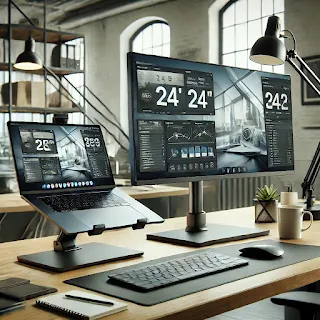### Comparison: Mobile Monitor Extender vs. Regular Monitor
Here’s a detailed comparison of mobile monitor extenders and regular monitors, broken down by key factors like **price**, **reliability**, **comfort**, **pros**, and **contrasts**:
---
### 1. **Price**
- **Mobile Monitor Extender**
- **Range**: $100 - $300
- **Explanation**: Mobile monitor extenders are typically more affordable, as they offer added portability and a second screen without the full standalone monitor features.
- **Regular Monitor**
- **Range**: $150 - $800+ (depending on size, resolution, and features)
- **Explanation**: Regular monitors, especially those with higher resolutions (like 4K), can be more expensive due to their larger display, better image quality, and specialized features like ultra-wide aspect ratios or higher refresh rates.
### 2. **Reliability**
- **Mobile Monitor Extender**
- **Explanation**: Mobile monitor extenders are usually reliable in terms of basic functionality, but their build quality can vary depending on the brand. They often rely on hinges or attachments to fit onto laptops, which can wear out over time.
- **Durability Issues**: Hinges or connectors may wear out with frequent travel or rough handling.
- **Regular Monitor**
- **Explanation**: Traditional monitors are built to last and are typically more durable as they are stationary and don’t involve moving parts. The internal components (display, panel, etc.) tend to last for many years, especially with reputable brands.
- **Durability**: High durability due to fewer mechanical parts, generally reliable with long lifespan.
### 3. **Comfort**
- **Mobile Monitor Extender**
- **Comfort Level**: Designed for portability, allowing the user to easily add a second screen on the go, which is a major advantage for remote workers or frequent travelers.
- **Ergonomics**: While they add a second screen for multitasking, they might not always be positioned ergonomically (depending on the attachment method), potentially leading to discomfort during long hours of use.
- **Regular Monitor**
- **Comfort Level**: Offers better ergonomics as regular monitors usually come with adjustable stands (height, tilt, swivel), providing better comfort for long working hours.
- **Ergonomics**: Highly ergonomic, especially models with adjustable stands, ensuring long-term comfort.
### 4. **Pros**
- **Mobile Monitor Extender**
- **Portability**: Lightweight and compact; designed to travel with you.
- **Convenience**: Easy to attach to a laptop and provides dual-screen functionality on the go.
- **Space-saving**: Doesn’t require additional desk space, as it attaches directly to your laptop.
- **Regular Monitor**
- **Larger Screen**: Typically larger (24-32 inches), offering more screen real estate for productivity and media consumption.
- **Better Display Quality**: Higher resolution (1080p, 1440p, 4K) and color accuracy for tasks like photo editing, gaming, or video watching.
- **Ergonomic Adjustment**: Adjustable stands and options for mounting offer flexibility in positioning.
### 5. **Contrasts**
- **Mobile Monitor Extender**
- **Size**: Smaller in size (usually 12-15 inches), which may be limiting for certain tasks.
- **Usage**: Great for remote work or as a temporary second screen solution.
- **Flexibility**: Portable, but with limited adjustability and often lower display quality compared to regular monitors.
- **Regular Monitor**
- **Size**: Much larger, offering more workspace and often multiple connectivity options (HDMI, DisplayPort).
- **Usage**: Ideal for permanent desk setups, gaming, video editing, and extended periods of work.
- **Flexibility**: Less portable but offers better visual experience and flexibility in terms of positioning, resolution, and screen quality.
---
### Conclusion
- **Mobile Monitor Extender** is ideal for people who need **portability, compact design**, and a **convenient second screen** for travel or working remotely. However, it may lack in terms of **durability and comfort** for extended use.
- **Regular Monitor** is a better choice for those who work in a **fixed location**, requiring a **larger, higher-quality display** with better **ergonomics and reliability** for long-term use. However, it’s bulkier and less portable.


No comments:
Post a Comment
Note: Only a member of this blog may post a comment.